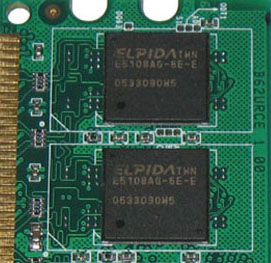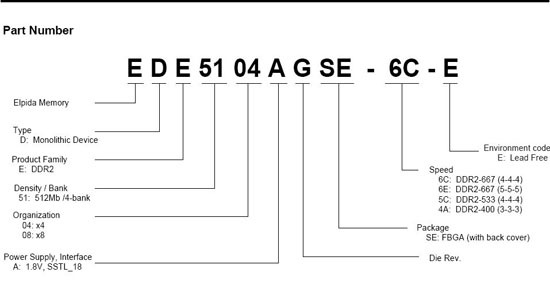Mushkin XP2 PC2-5300 DDR2 – Xtreme Performance Memory
by Steve Carmel & Wesley Fink on March 28, 2006 12:01 AM EST- Posted in
- Memory
Mushkin XP2 PC2-5300 DDR2
Has the time come for DDR2 memory? Is now the time for enthusiasts to finally embrace DDR2 technology with better performance on Intel based platforms, and the promised Holy Grail of AMD's new AM2 socket with DDR2 support and built-in memory controllers?
Socket AM2, the 940 pin DDR2-ready Athlon 64 socket, will be unleashed upon consumers some time this summer, most likely by the end of July. AMD is expected to have working samples in place by the time of Computex 2006, which will be held from June 6 th to June 10 th in Taipei.
After DDR2 was first introduced for Intel, Micron D fat body chips gained enthusiast's attention in a big way, due to the lower latency timings and the ability to push performance to much higher memory speeds. Unfortunately, the Micron fat body D DDR2 memory chips are now history.
Perhaps Mushkin has discovered an alternative to the famed Fat Body IC's. While 3-3-3 at DDR2-667 is not quite as fast as the 3-2-2 timings seen with the best Micron chips, it is still among the fastest specifications that you will find for DDR2-667 memory modules. It is also worth mentioning that the older, and now discontinued, Micron Fat Body D chips were never specified as performing at 3-2-2- timings, so perhaps these new Mushkin Elpida modules will do even better than their rated timings.
With that in mind, the goal in testing was to see exactly what the new Mushkin XP2 memory could do in our memory test suite. How do the new Mushkin DDR2 with Elpida chips compare to the top Micron DDR2 memory? Is this new Mushkin DDR2 memory a worthy choice for current Intel and future AM2 enthusiasts?
Product Specifications and Information
Mushkin confirmed the use of Elpida IC's for the Extreme Performance Black Series (XP) memory modules.
Elpida provided a data sheet for these integrated circuits, which are being utilized by Mushkin in this XP series memory.
In a screen capture from the Elpida data sheet, you can see how to decode the information from the actual IC part number. We are examining the EDE5108AGSE-6E-E part. The "A" in the part number is indicative of voltage (i.e. this is normally specified as a 1.8 volt part).
On July 28, 2005, Mushkin announced their new heat spreader for their high performance memory modules. Mushkin claimed that the new heat spreaders provided 58% more surface area than their previous designs.
Below is a photograph of the sample heat sink design, which Mushkin sent back in July 2005 for feedback.
Has the time come for DDR2 memory? Is now the time for enthusiasts to finally embrace DDR2 technology with better performance on Intel based platforms, and the promised Holy Grail of AMD's new AM2 socket with DDR2 support and built-in memory controllers?
Socket AM2, the 940 pin DDR2-ready Athlon 64 socket, will be unleashed upon consumers some time this summer, most likely by the end of July. AMD is expected to have working samples in place by the time of Computex 2006, which will be held from June 6 th to June 10 th in Taipei.
After DDR2 was first introduced for Intel, Micron D fat body chips gained enthusiast's attention in a big way, due to the lower latency timings and the ability to push performance to much higher memory speeds. Unfortunately, the Micron fat body D DDR2 memory chips are now history.
Perhaps Mushkin has discovered an alternative to the famed Fat Body IC's. While 3-3-3 at DDR2-667 is not quite as fast as the 3-2-2 timings seen with the best Micron chips, it is still among the fastest specifications that you will find for DDR2-667 memory modules. It is also worth mentioning that the older, and now discontinued, Micron Fat Body D chips were never specified as performing at 3-2-2- timings, so perhaps these new Mushkin Elpida modules will do even better than their rated timings.
With that in mind, the goal in testing was to see exactly what the new Mushkin XP2 memory could do in our memory test suite. How do the new Mushkin DDR2 with Elpida chips compare to the top Micron DDR2 memory? Is this new Mushkin DDR2 memory a worthy choice for current Intel and future AM2 enthusiasts?
Product Specifications and Information
Mushkin confirmed the use of Elpida IC's for the Extreme Performance Black Series (XP) memory modules.

Elpida provided a data sheet for these integrated circuits, which are being utilized by Mushkin in this XP series memory.
| PC2-5300 667MHz DDR2 | CL 3-3-3 (CAS-TRCD-TRP) |
| 2GB (1024MB x 2) | Unbuffered |
| Improved Black Heat Spreader with new thermal tape | Lifetime Warranty |
| 2.1 - 2.3 Volts | 240 Pin DIMM |
| Elpida IC: E5108AG-6E-E | Brain Power PCB: MLL E186014 B62URCE |
In a screen capture from the Elpida data sheet, you can see how to decode the information from the actual IC part number. We are examining the EDE5108AGSE-6E-E part. The "A" in the part number is indicative of voltage (i.e. this is normally specified as a 1.8 volt part).

On July 28, 2005, Mushkin announced their new heat spreader for their high performance memory modules. Mushkin claimed that the new heat spreaders provided 58% more surface area than their previous designs.
Below is a photograph of the sample heat sink design, which Mushkin sent back in July 2005 for feedback.











11 Comments
View All Comments
PrinceGaz - Tuesday, March 28, 2006 - link
"I know that the built in spreaders are fantastic for heat dissapation"There is a lot of debate over whether heatspreaders made any difference at all even with the hotter running DDR modules at 2.5V+. Many people believe the heatspreaders are more to do with making them look good rather than perform better. I really don't know either way as all the heatspreaders on my DDR modules seem to do is give a larger flat surface area for the heat to be dissipated from after the heat has been conducted from the individual chips (the heatspreaders even with overvolted modules don't feel particularly warm), and I'm unconvinced if
(a) there is any significant surface area in contact between the chips and heatspreader, let alone whether any thermal compound was used
(b) that might mean you would get better heat dissipation *without* a heatspreader as the cool air would be blowing directly over the memory chips themselves instead of having a heatspreader in the way
Given that DDR modules at normal voltages (up to 3V anyway, I'm not talking about the OCZ modules that could take 3.5V or so -- more than old SDRAM even) without getting very warm, why would cooler running DDR2 need heatspreaders unless pushed up from 1.8V to at least 2.3V. Memory chips don't give off much heat even when over-volted so heat-spreaders seem unnecessary, especially on DDR2 modules. Once you combine that with the fact that at least half the surface area of a memory module without a heatspreader is taken up by the memory chips anyway, there doesn't really seem much point in adding something to "spread" the heat over what is only a slightly larger area.
I will concede that heatspreaders look good though, and the minimal cost of them is returned many times in every premium module they sell with them.